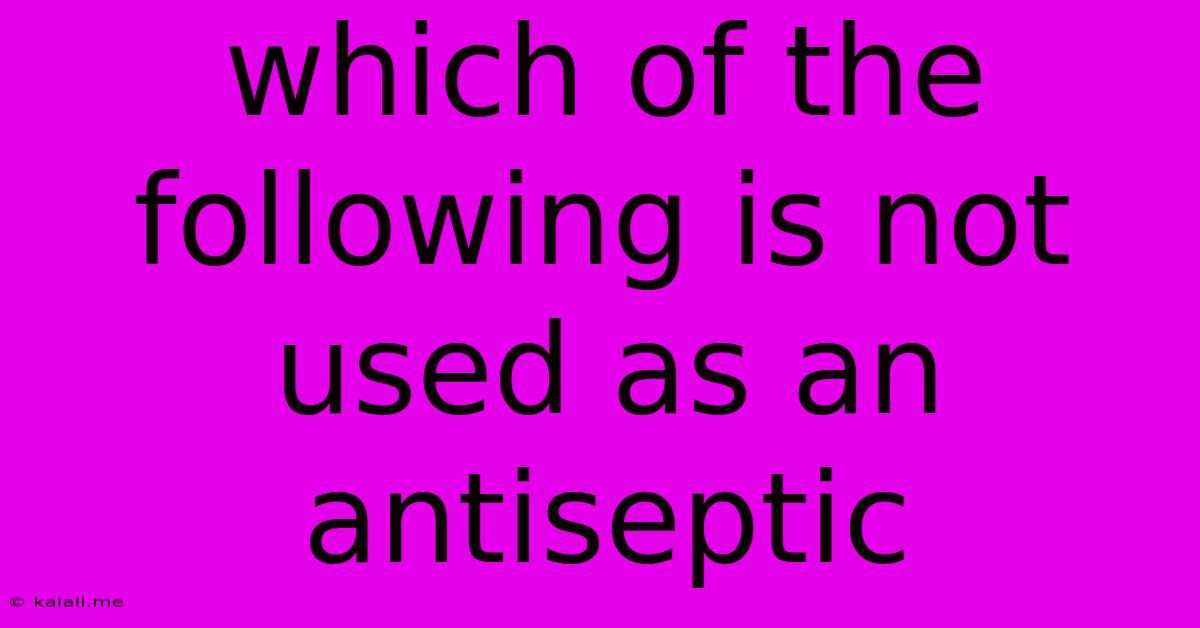Which Of The Following Is Not Used As An Antiseptic
Kalali
Jun 15, 2025 · 3 min read

Table of Contents
Which of the following is NOT used as an antiseptic?
This article will explore the world of antiseptics, clarifying what they are and, importantly, highlighting substances that are not used for antiseptic purposes. Understanding the difference between antiseptics and disinfectants is crucial for maintaining hygiene and preventing infection. We'll examine common household and medical substances, identifying which one doesn't fit the antiseptic bill. Knowing which substances are safe and effective for antiseptic use is essential for personal hygiene and preventing the spread of disease.
What is an Antiseptic?
An antiseptic is a substance that prevents or inhibits the growth of microorganisms, such as bacteria, fungi, and viruses, on living tissues. This is key; antiseptics are designed to be applied to the skin and mucous membranes to reduce the risk of infection. They work by either killing microorganisms (bactericidal) or preventing their growth (bacteriostatic). Examples of common antiseptics include:
- Alcohol (Isopropyl alcohol and Ethyl alcohol): These are widely used for their quick-acting antimicrobial properties.
- Hydrogen peroxide: This releases oxygen, which is toxic to many microorganisms.
- Iodine: A potent antiseptic with broad-spectrum activity.
- Chlorhexidine: A powerful antiseptic often used in hospitals and healthcare settings.
The Difference Between Antiseptics and Disinfectants
It's important to distinguish between antiseptics and disinfectants. While both combat microorganisms, they are used in different contexts:
- Antiseptics: Used on living tissue.
- Disinfectants: Used on inanimate objects (surfaces, equipment).
Failing to understand this difference can lead to accidental misuse and potential harm.
Substances NOT Used as Antiseptics:
Now, let's address the core question: While many substances have antimicrobial properties, not all are suitable for use as antiseptics on living tissue. For example:
- Bleach (Sodium hypochlorite): Although a powerful disinfectant, bleach is highly corrosive and damaging to living tissue. Applying it to skin or mucous membranes can cause severe burns and irritation.
While bleach effectively kills microorganisms on surfaces, its corrosive nature makes it unsuitable for antiseptic use. Other strong disinfectants, such as certain phenolic compounds, also fall into this category due to their potential toxicity to living cells. Always adhere to the manufacturer's instructions and consult a healthcare professional when dealing with disinfectants and antiseptics.
Choosing the Right Antiseptic
The choice of antiseptic depends on the situation. For minor cuts and scrapes, alcohol or hydrogen peroxide might suffice. For more serious wounds or surgical procedures, stronger antiseptics like chlorhexidine or iodine solutions are typically employed under medical supervision. Remember, proper wound care practices, including cleaning the wound thoroughly with soap and water before applying any antiseptic, are equally vital in preventing infection.
Conclusion:
Understanding the properties of antiseptics and disinfectants is crucial for maintaining hygiene and preventing infection. While many substances possess antimicrobial qualities, only those safe for application to living tissue should be used as antiseptics. Bleach, due to its corrosive nature, is a prime example of a substance that should never be used as an antiseptic. Always prioritize safety and consult a healthcare professional when dealing with wounds or infections.
Latest Posts
Latest Posts
-
How Many Days In The Year Excluding Weekends
Jul 30, 2025
-
5 Letter Word With 3 Vowels And 2 Consonants
Jul 30, 2025
-
1 Lb Macaroni Is How Many Cups
Jul 30, 2025
-
How To Hand Sew Two Pieces Of Fabric Together
Jul 30, 2025
-
What Is 1 4 Cup 1 4 Cup
Jul 30, 2025
Related Post
Thank you for visiting our website which covers about Which Of The Following Is Not Used As An Antiseptic . We hope the information provided has been useful to you. Feel free to contact us if you have any questions or need further assistance. See you next time and don't miss to bookmark.